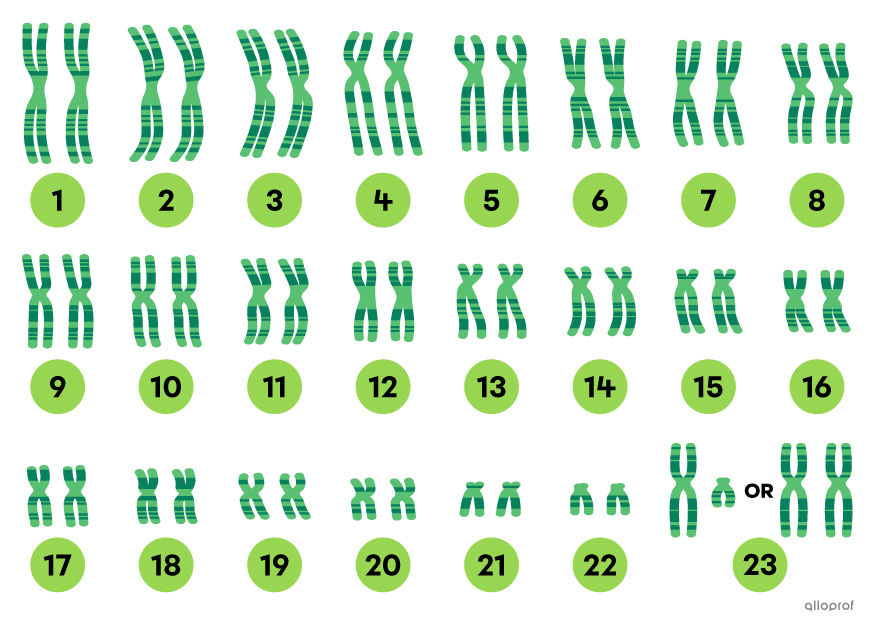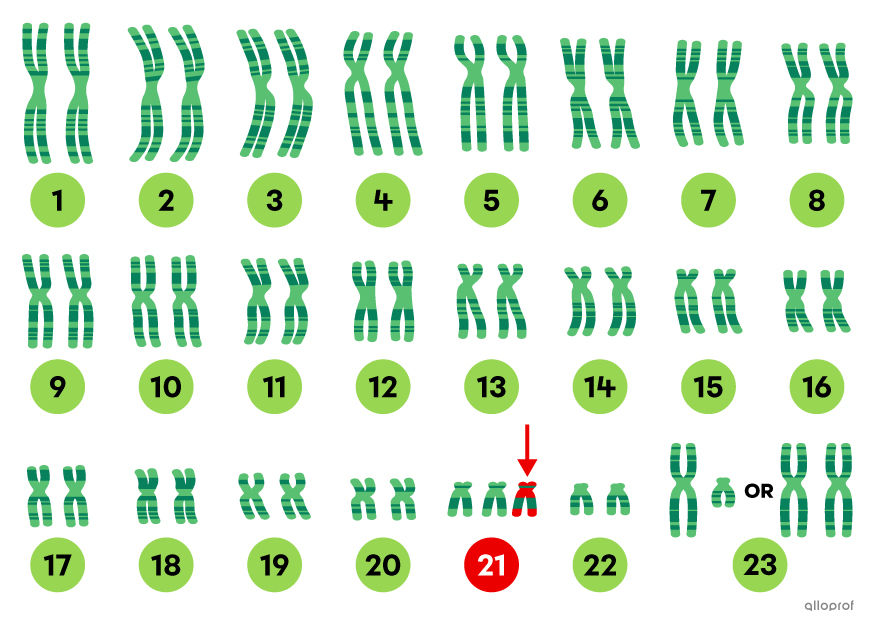A genetic disease, or inherited disease, is a disease caused by an abnormality in the DNA.
Genetic diseases can have multiple causes and fall into 3 broad categories.
A chromosomal abnormality is an abnormality caused by an excess of chromosomes, a lack of chromosomes, or some other defect related to an individual's chromosomes. A chromosomal abnormality is not due to genetic mutations.
During fertilization, an ovum with 23 chromosomes fuses with a spermatozoon with 23 chromosomes. After multiple stages, a child is born and their cells have a total of 46 chromosomes organized into 23 pairs.

In some cases, the ovum or the spermatozoon may have 24 chromosomes instead of 23. Therefore, the baby will have a total of 47 chromosomes, which is 22 pairs and 1 trio of chromosomes. This is called trisomy. Trisomy is characterized by a growth disorder and intellectual development disorders of varying degrees.

The most common trisomy is trisomy 21 or Down syndrome. It occurs when chromosomes number 21 are in a triad. There are also other types of trisomy such as trisomy 13 (Patau’s syndrome) and trisomy 18 (Edwards’ syndrome).
Judith Scott was an internationally renowned sculptor with Down syndrome. During her life, she created over 200 art pieces using textile fibres. Her work is exhibited in North America and in many European countries.

Bepsy, Shutterstock.com
Jean-François Hupé is a Quebec actor with trisomy 21 (Down syndrome). He has acted in several television series and films such as Virginie and Une autre histoire.

Portrait de Jean-François Hupé [Photography], Centre des arts de la scène, 2022, Les Muses, (URL).
There are several other types of chromosomal abnormalities. For example, it is possible for an individual to have one fewer chromosome than normal. This is known as monosomy.
Generally, individuals have two sex chromosomes characterized by the letters XX (female sex) and XY (male sex). Turner syndrome occurs when an individual has only one X chromosome, or the second X chromosome is shortened. Individuals affected by this syndrome have, for example, growth and fertility problems.
A monogenic disease, or Mendelian disease, is a disease that occurs due to the mutation of one or more genes.
The mutation(s) in question may occur during the development of the embryo. At birth, the child's cells carry one or more faulty genes that could cause a genetic disease.
In most cases, parents pass on genetic mutations to their children. Depending on their genotype (homozygous dominant, homozygous recessive, or heterozygous), the child may or may not develop the disease transmitted by the parents. So Mendel's laws apply.
In addition, the biological sex of the child can have an influence the progression of the disease.
-
Familial hypercholesterolemia is a dominant monogenic disease. Only one of the two parents needs to transmit the genes carrying the disease for the child to be affected. The disease causes cholesterol levels in the blood to be very high, which promotes the early onset of cardiovascular diseases.
-
Polydactyly is also a dominant monogenic disease. A person with polydactyly has more than 5 fingers on their hands and/or more than 5 toes on their feet.
-
There are several subtypes of Leigh syndrome. Lactic acidosis of Saguenay–Lac-Saint-Jean region, also known as Leigh syndrome, is a recessive monogenic disease. It means that both parents must pass on the gene responsible for the syndrome for their child to be affected. The disease causes developmental delays and a disorder in the regulation of blood pH.
-
In women, hemophilia is a recessive monogenic disease. Hemophilia affects the body's ability to clot blood.
Multifactorial diseases, or diseases with complex heredity, are diseases that occur because of one or more genetic mutations and because of several other factors.
Like monogenic diseases, multifactorial diseases can be caused by the mutation of one or more genes. However, the presence of mutations is not sufficient for the development of these diseases. In fact, lifestyle (e.g., diet, physical activity, etc.) and environmental factors (e.g., exposure to certain toxins, excessive exposure to the sun, etc.) are factors that can affect the chances of developing this type of genetic disease. So Mendel's laws are not sufficient to predict the likelihood of developing multifactorial diseases.
Type 2 diabetes is a multifactorial genetic disease. It affects the body's ability to produce insulin, which is an essential hormone for regulating blood sugar levels. The disease can also affect the ability of cells to respond to insulin.
Diabetic parents will not necessarily give birth to a diabetic child, even if the defective genes are passed on to the child. On the other hand, the presence of defective genes increases the likelihood that the child will develop the disease while growing up.
In addition, other factors, such as a diet high in fat and sugar, lack of exercise, and the use of certain medications, can increase the risk of the disease developing during the individual's lifetime.
Finally, an individual without a family history of diabetes could develop the disease if exposed to other risk factors.
Breast cancer, multiple sclerosis, and Crohn's disease are also multifactorial genetic diseases.
Centre des arts de la scène. (2022). Portrait de Jean-François Hupé [Photographie]. Les Muses. https://lesmuses.org/wp-content/uploads/2015/02/Muses0916HR-768x1024.jpg